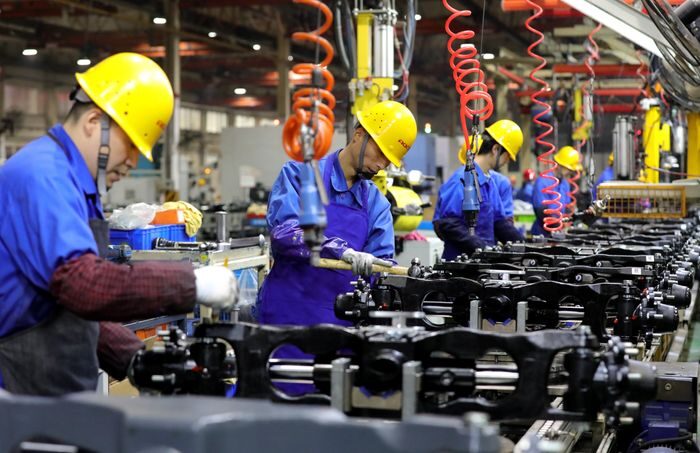Sometimes, however, the way economic concepts are framed can be misleading. New research is shedding light on how "derisking" is actually playing out. The preliminary conclusions are concerning: Much of the resiliency that supply-chain measures are designed to create may be illusory. Moreover, more-complicated global supply chains are creating new risks, which policymakers might not fully appreciate.
Pairing protectionist policies toward China with genuine trade opening toward friendlier nations would enhance their effectiveness, but may not be politically expedient.
Rising tensions with the West, in concert with other factors such as the coronavirus pandemic and China's emerging strength in areas like electric vehicles, have begun to seriously reorder China's trade relations. China sent just 45% of its exports to the European Union and major developed democracies like the U.S. in November, figures from data provider CEIC show. That was the lowest in over a decade and down from about 54% as recently as early 2022.
Meanwhile U.S. imports from Vietnam, Mexico and other third countries have shot up as growth in shipments from China has lagged behind.
Comment: Because, via 'complexity', the US continues to buy the same Chinese products but through intermediaries, just like is happening with Russian energy products? Pentagon buying Russian oil via Greek intermediaries - WaPo
But does this change represent more resilient supply chains? Or just more expensive, opaque and complex ones?
Trump administration tariffs on China are five years old — not that long when one considers everything involved in replacing China as the world's factory floor. Still, the balance of evidence so far suggests the downsides of complexity are outweighing some of the benefits. That means higher costs for U.S. buyers. It could also make sanctions or trade restrictions targeting China more difficult, should a real conflict ever erupt over Taiwan or other hot spots.
To be sure, building factories in Southeast Asia, India or Mexico has advantages. A phone or vehicle manufacturer in Vietnam might be more inclined to use Japanese or Korean parts, or even build a battery plant locally, rather than just source everything in China. That could, eventually, help build and maintain real resiliency.
Comment: Business will source products from the most efficient and/or cheapest seller, and, as it is, China is currently the world leader for a great variety of products, it has been for years, and there's little reason to believe they'll slow down.
But for now, Asian supply chains often appear to simply be lengthening: assembling Chinese parts in Vietnam or Thailand, for example, rather than in China itself. One striking finding of an October paper from researchers at the Bank for International Settlements was that cross-border supplier networks — especially those involving China and the U.S. — have lengthened since 2021 but not become more "dense." In other words, the average number of suppliers per customer hasn't increased. More circuitous supply chains with the same number of suppliers smacks of increased complexity and reduced transparency — but not necessarily more resilience.
The biggest winner appears to be Southeast Asia. China's exports to Russia, as a percentage of its total exports over the year ending last November, have risen about 1.3 percentage points since 2017 to just over 3% of total exports. But exports to Southeast Asia are now about 16% of the total — over 3 percentage points higher. And the percentage of Vietnam's electronics imports sourced from China has surged over the same period.
All of this is great for Southeast Asia — but it creates new problems too. First, it probably means higher prices since supply chains are longer but, at least so far, actual competition among suppliers doesn't seem to have increased much. A September study from the Centre for Economic Policy Research, a European think tank, for example, found that the U.S.'s sharp shift away from Chinese imports and toward Vietnamese ones since 2017 was matched by a nearly 10% rise in the cost of U.S. imports from Vietnam over the same period. Studies from the Federal Reserve, the Peterson Institute for International Economics and elsewhere have shown that Trump-era tariffs probably reduced overall U.S. manufacturing employment and output by raising the cost of imports for downstream industries.
Second, it means that in the next crisis, applying economic pressure on China might be more complicated. Direct sanctions or import bans targeting China in a crisis over Taiwan or the South China Sea would be difficult enough: Would Washington target Vietnamese and Mexican imports too? Would EU member states ban imports from Hungary, where Chinese battery makers are investing heavily?
By forcing supply chains to superficially rearrange now, Western democracies may have squandered a portion of their real, or perceived, leverage. And politicians, incorrectly assuming that they have sufficiently insulated their economies, may miscalculate and stumble into an actual hot conflict.
One way to encourage the emergence of a truly denser, more resilient network outside China — and one featuring real competition rather than firms finding ways to game new trade barriers — could be to join trade deals excluding China and led by close allies like Japan. But the toxic politics of trade in the U.S. mean that many politicians will probably remain focused on creating the appearance of derisking, rather than doing what is necessary to make it a reality.




How about a price cap ?